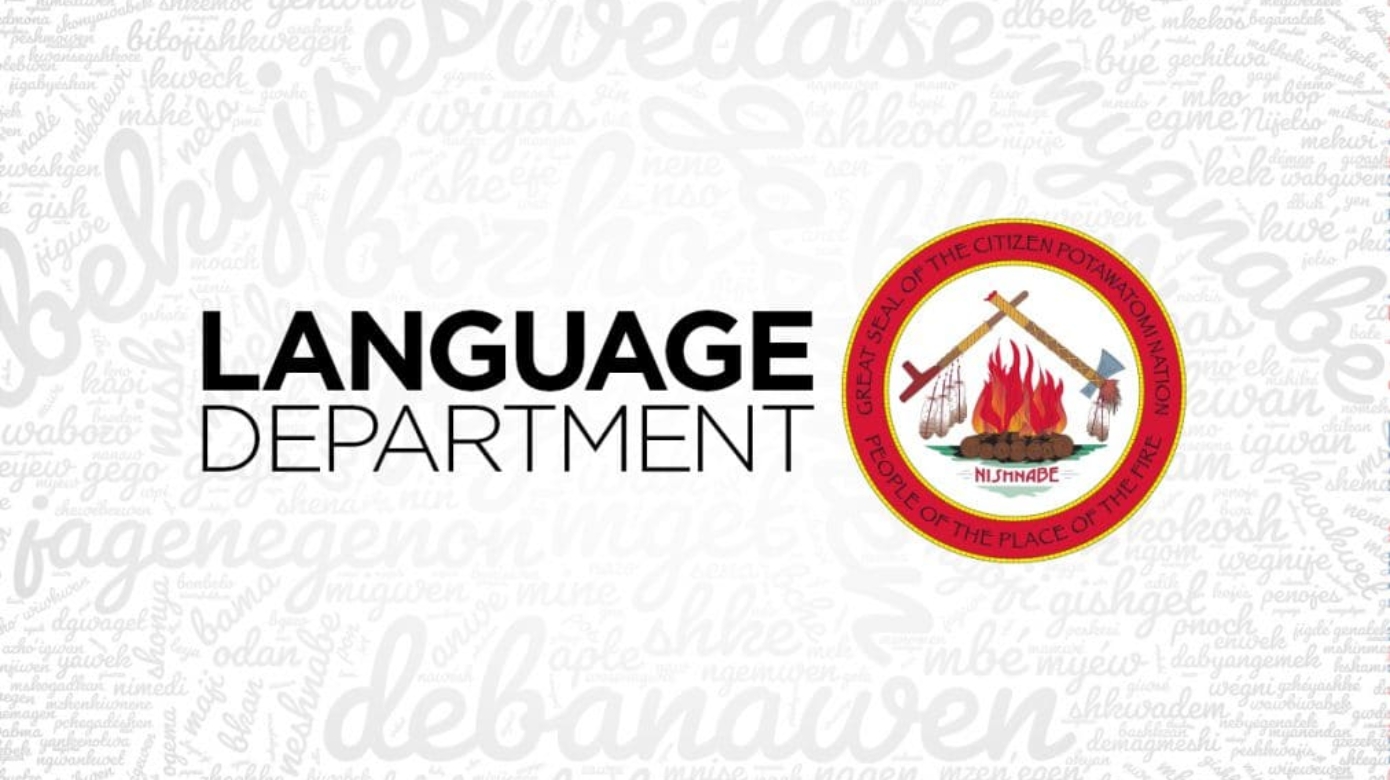By Justin Neely, CPN Language Department Director
Bozho Jayek
(Hello everyone),
We had a great Festival weekend. It was kyetnam gshatemget (really hot). We had new signs made for the different events and locations with QR codes that people could use to listen to the words.
We had a tremendous turnout for our two rounds of Potawatomi Bingo. We had over 125 people for each game on Friday and Saturday. It was great to listen to folks call the words back. It was also nice to hear the kids using the language.
We also had a nice turnout for our children’s class and beginner class. I would like to say Igwien to my staff for doing an awesome job. We had about 15 folks participate in our scavenger hunt, and we will be sending out prizes soon. I will post the translation of the scavenger hunt below.
We had our first four children’s books in the Festival bags. A few bags did not receive all four books, so if you didn’t get all four, be sure to sign up and register for our next round of books. Let us know, and we will include the previous books in your mailout. The live registration started July 1. Please be patient with us as we prepare a mailing list and get the books out to you. To get on the list, go to the portal at portal.potawatomi.org then click on “Register for books.”
This Festival is the first ever that a Citizen Potawatomi drum set up for dance. We have been doing hand games for a number of years, but this year, thanks to a dedicated group of men, we were ready for the dance as well. Migwetch to all the singers on Sengo Zibiwes. It was an honor and privilege to sing with each of you. I am particularly proud of the young men who sang with us.
Recently we partnered with Google on a project called Woolaroo. This allows a person to choose a language such as Potawatomi and then use their camera to take a picture of an object. Then the phone identifies what type of object it is looking at. Sometimes there will be multiple things it picks up. Once you choose what to use, it will play audio for you. Potawatomi was one of the only Indigenous languages in North America chosen for this initial project. In order to do this, I had to translate the 2,500 or so most Googled terms in Potawatomi and then record an audio file for each. I am very pleased with how it turned out. Hopefully, each of you will try and use Woolaroo.
We have three interns with us this summer. They are a very talented group of folks. We also have one fellowship who was an intern last year but is a traveling scholar this year. While interning in the Language Department, they have the opportunity to learn the language and also assist us in a variety of tasks. Everything from working with our online dictionary adding images, example sentences and audio to sending out books and even writing music in the language. It’s a very exciting time in the Language Department. We are currently preparing for the upcoming Potawatomi Gathering/Language Conference. This will be the first such gathering since the onset of COVID. We are all looking forward to getting together with our relatives from across mshike mnise, Turtle Island.
Scavenger hunt translation
Zhyan Yatsogewgemek. Wegni je ga yowat ga zhegewat ode wigwam. (Go to the Museum. What did they use to build the wigwam?) Answer: Kishki (Cedar) or Wigwas (Birch bark)
Bidek Bodewadmi moshkek, weni je zhabwenat jayek? (Inside the Potawatomi flood, who saves everyone?) Answer: Zheshko (Muskrat)
Wegni je nebyegemgek I yazhdéyakw’egen beshoch camping area? (What is written on the sign close to the camping area?) Answer: Eje kkezok (Camping)
Zhyan ibe Yatokewgemek. Wegni je nyew mshkekiwnen? (Go to the museum. What are the 4 medicines?) Answer: Tobacco, cedar, sage and sweetgrass
Zhyan Yatsokewgemek. Ni jet so pitnegwet I menomen bidek mkek? (Go to the museum. How much rice is in the container?) Answer: 300 pounds
Zhyan Wab numawgemgok. Wech mokek Gordon Cooper Drive. Wech nawkwek yatsokewgemek. Gda-mkan I sen beshoch. Wegni je nebyegemgek? (Go to the white church east of Gordon Cooper Drive. South of the museum. You should find a rock close by. What is written on it? Answer: The last Tribal annuity payment.
Ni pi je edawat gi bodewadmik bwamshe mskwa kik? (Where did the Potawatomi live before Oklahoma?) Answer: Michigan, Kansas, Illinois, Indiana and Wisconsin.
Weni je ga dawat ibe mtek wigwam beshoch yatsogewgemek? (Who lived over in the log cabin near the museum?) Answer: Bourbonnais family.
Zhyan ibe “Mdemoze ngwagen.” Azhgen Wegni je ga nebyegewat ode yazhdéyakw’genek? (Go to “rainbow” bridge. What is written on the sign?) Answer: built 1916/1917
Zhyan ibe Mdodowgemek. Mdodowgemek wech nawkwek Sengo Zibiwes mine wech ksenyak golf course. Wegni je nebyegewat I yazhdéyakw’gen. (Go over to the sweatlodge. The sweat is south of Squirrel Creek and north of the golf course. What is written on the sign?) Answer: Be careful if you have any health conditions.
Wegni je wje igwan bidgeyak I madmowen wawyeyawen anake nimediwen wawyeyawen? (What direction do we enter the prayer circle and dance ring?) Answer: East.
Zhyan “Shkode mbes” Shkweyak shkode mbes dawewgemek. Ni je ezh ne kaswat gi gigoyek bidek I mbes? Nekshe I yazhdéyakw’gen. (Go to “Fire Lake” behind FireLake store. What are the fish called in the lake? Look for the sign.) Answer: bass, carp, catfish, sunfish
Ni je ezhnekadek I myew beshoch mbish mkek? (What is the name of the road close to the water tower?) Answer: Mbish Drive
Ni je kedyen “Stop” Bodéwadmimwen. (How do you say stop in Potawatomi?) Answer: Gashnen.
Iw
(End)

